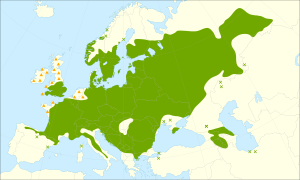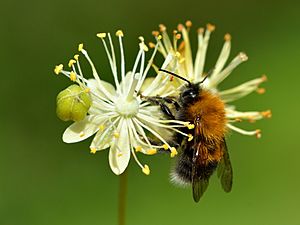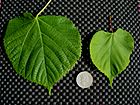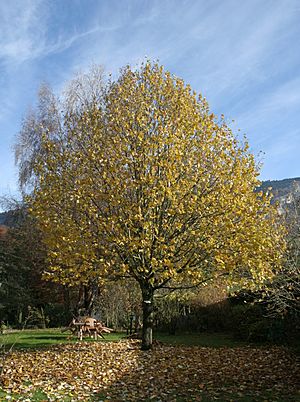Small-leaved lime facts for kids
Quick facts for kids Small-leaved lime |
|
|---|---|
 |
|
| Scientific classification | |
| Genus: |
Tilia
|
| Species: |
cordata
|
 |
|
| Distribution map | |
The Tilia cordata, often called the small-leaved lime or small-leaved linden, is a type of tree. It grows naturally across much of Europe. You might also hear it called the little-leaf linden. In some parts of South East England, it was traditionally known as the pry tree. This tree can be found from Britain all the way to the Caucasus mountains and western Asia. In warmer southern areas, it usually grows at higher, cooler elevations.
Contents
What the Small-Leaved Lime Looks Like
The small-leaved lime is a deciduous tree. This means it loses its leaves in autumn. It can grow very tall, usually between 20 to 40 meters (about 65 to 130 feet). Its trunk can be up to 1 meter (about 3 feet) wide. Some lime trees in Germany are thought to be over 1000 years old!
When the tree is young, its bark is smooth and grayish. As it gets older, the bark becomes rougher with ridges. The top part of the tree, called the crown, is usually round or shaped like an oval.
The leaves grow one after another along the branch. They are rounded or heart-shaped, about 3 to 8 centimeters (1 to 3 inches) long and wide. They are mostly smooth, but you might see small tufts of brown hair where the leaf veins meet. The buds are pointed and reddish.
In early summer, the tree produces small, yellow-green flowers. These flowers grow in groups of five to eleven. They have a strong, sweet smell that attracts many bees. The flowers are held above a special leafy part called a bract.
After the flowers, small, dry, nut-like fruits appear. They are about 6 to 7 millimeters long. Each fruit usually holds one or two brown seeds. Unlike some other lime trees, these fruits are not ribbed and are easy to crack open.
Where the Small-Leaved Lime Grows
These trees like good, rich soil. However, they can also grow in sandy, less fertile soils. They don't handle very dry conditions well. In winter, the dormant shoots of the small-leaved lime can survive very cold temperatures, even as low as -34 °C (-29 °F).
In Britain, the small-leaved lime is a sign of ancient woodland. This means it has been growing in the same forest for a very long time. Because it's becoming rarer, some woods with these trees are protected. For example, Cocklode Wood in England has many medieval small-leaved lime trees.
Scientists have studied pollen from old peat deposits. This shows that Tilia cordata was a common tree in the southern Lake District around 3100 BC. It spread quickly and became very common in some valleys. Some of the mature trees alive today are thought to be around 800 years old. It's hard to know their exact age because the very center of old trees often breaks down.
Pests and Diseases
The small-leaved lime is quite strong against diseases. One common issue is leaf scorch if the tree is planted in dry soil. This makes the leaves look burnt, but it's not a big problem because the leaves fall off in autumn anyway.
Some insects can bother the tree. These include Japanese beetles, aphids, lace bugs, and different kinds of moths. One well-known moth is the Lymantria dispar dispar, also called the gypsy moth. This moth is an invasive species in North America. People are encouraged to remove its cocoons from tree bark to help stop it from spreading.
How People Use the Small-Leaved Lime
The small-leaved lime is a very popular ornamental tree. This means it's planted for its beauty. In the 17th and 18th centuries, it was often used to create beautiful avenues, like the famous Unter den Linden in Berlin.
In North America, it's often planted instead of the native American linden. It's popular because its dense leaves provide good shade. It's also a good tree for planting along streets. In Europe, these trees are sometimes shaped by heavy pruning, which they can survive well.
The small-leaved lime can also be trained as a bonsai tree. This is a miniature tree grown in a pot. It's important to train it slowly, over several months, to keep the tree healthy.
Before guns were invented, the wood of this tree was often used to make shields.
This tree grows best in soil that is slightly acidic to slightly alkaline (pH 5.0 to 8.0). It likes moist, well-drained soil and can even survive some flooding. However, it doesn't do well in very salty soil.
Famous Trees
The Najevnik linden tree in Slovenia is a very old and thick Tilia cordata. It's about 700 years old and is the thickest tree in Slovenia. It's a special place where cultural events happen, and Slovenian politicians even have a meeting there every June.
Different Types of Lime Trees
- Common Lime: The small-leaved lime can easily mix with another type of lime tree called Tilia platyphyllos. The tree that results from this mix is known as the common lime, or Tilia × europaea.
Special Varieties (Cultivars)
Plant growers have developed special varieties of the small-leaved lime:
- Corinthian ('Corzam'): This type has a neat, pyramid shape and darker, smaller leaves. It's also good at resisting Japanese beetles.
- Greenspire: This is a very common variety, known for growing quickly and looking good. It can survive well in tough conditions.
- June Bride: This variety has a strong pyramid shape and many more flowers than other types.
- Winter Orange: This one has beautiful red-orange-brown stems and reddish buds, especially in winter. It has won an award from the Royal Horticultural Society.
Linden Flower Tea
In many parts of Europe, people make a traditional herbal tea from linden flowers. It's called lime tea or linden tea in Britain, and tilleul in France.
Linden Honey
Bees collect nectar from the small-leaved lime flowers to make a special kind of honey. This "linden honey" is popular across Europe and is thought to be very healthy.
Leaves
The young leaves of the small-leaved lime can be eaten in salads. Sometimes, cattle also graze on them.
Linden Wood
The wood from the small-leaved lime is white and has a fine grain. It's not super strong, but it's a favorite for detailed woodcarvings. Famous carvers like Grinling Gibbons used it for beautiful works in places like St. Paul's Cathedral and Windsor Castle. It's also used for lighter projects like carved spoons, light furniture, and parts of bee hives.
Cultural Importance
The Tilia cordata is a very important tree in some countries. It is the national tree of the Czech Republic and the Slovak Republic. It is also one of two national trees in Latvia. The leaf of the Tilia cordata is also a national symbol of Slovenia.
Images for kids
See also
 In Spanish: Tilo norteño para niños
In Spanish: Tilo norteño para niños






